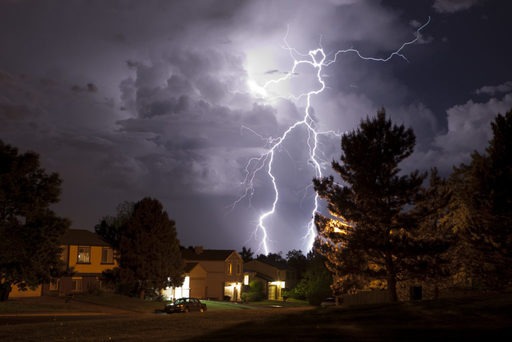
There’s nothing quite like embracing the splendor of nature by enjoying a lightning storm during a cool summer evening from afar. Of course, the “from afar” part is the key word, here. Get a little too close to lightning and you could put yourself at risk for injury or even death – and that risk isn’t exactly “one in a million,” either.
The Basics of a Lightning Strike
Understanding what happens during a lightning strike can help you reduce your risk of being injured when one occurs. Lightning is extremely loud and hot; it can blow your eardrums out and cause third-degree burns with ease if it strikes close enough to you.
The good news is that lightning rarely targets people – it’s far more likely to strike tall and metallic objects, like buildings. The one exception is if you’re in a field and you happen to be the tallest object around.
There are warning signs before a lightning strike occurs near you. You’ll feel tingling sensations or notice your hair standing on end — what you’re probably experiencing is a “positive streamer.” That means a lightning strike will happen on or near you within a short period of time.
The Crouching Position
With those basics laid out, it’s time to put them all to use. If you’re experiencing a positive streamer, crouch down with only the balls of your feet touching the ground and your heels connected. Put your hands over your ears and hold your breath. Also, avoid touching or being near metal objects.
Crouching lowers your profile, which reduces your chances of being struck. Additionally, having only the balls of your feet contacting the charged ground lowers the chances lightning will strike you directly. Lastly, connecting your heels together encourages electricity from the ground to travel through your feet instead of through your body.
Most lightning strikes produce about 120 dB of noise. That’s around 10 times louder than a jackhammer. Covering your ears will protect your eardrums, and possibly, prevent them from blowing even if you are struck.
Why hold your breath? It prevents you from breathing in the super-heated air around the strike, which might reduce lung damage. Lightning can reach temperatures of 53,540 degrees Fahrenheit – hotter than the surface of the sun.
The 30/30 Rule
Finding shelter is your priority during a lightning storm, and the 30/30 rule tells you how how dangerous the storm is. If you can’t count 30 seconds between each round of thunder, it’s close. Get inside of a building or car. Then, stay inside until 30 minutes pass after the last thunderclap.
Though being struck by lightning is exceedingly rare, you should do all that you can to avoid one if you’re caught in a storm. The crouching position might seem a bit strange, but it’s actually very effective for this scenario. Spend some time practicing crouching so that you can survive being caught in a lightning storm.











